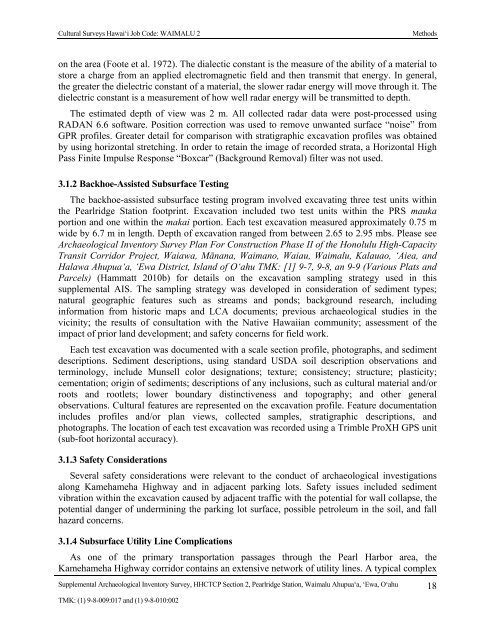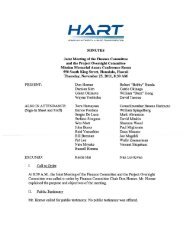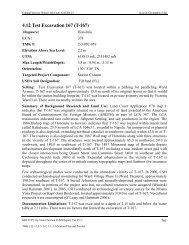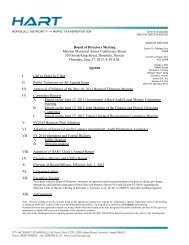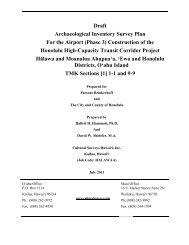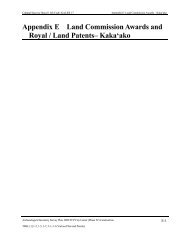Draft Supplemental AIS Report Kamehameha Highway Guideway
Draft Supplemental AIS Report Kamehameha Highway Guideway
Draft Supplemental AIS Report Kamehameha Highway Guideway
Create successful ePaper yourself
Turn your PDF publications into a flip-book with our unique Google optimized e-Paper software.
Cultural Surveys Hawai‘i Job Code: WAIMALU 2<br />
Methods<br />
on the area (Foote et al. 1972). The dialectic constant is the measure of the ability of a material to<br />
store a charge from an applied electromagnetic field and then transmit that energy. In general,<br />
the greater the dielectric constant of a material, the slower radar energy will move through it. The<br />
dielectric constant is a measurement of how well radar energy will be transmitted to depth.<br />
The estimated depth of view was 2 m. All collected radar data were post-processed using<br />
RADAN 6.6 software. Position correction was used to remove unwanted surface “noise” from<br />
GPR profiles. Greater detail for comparison with stratigraphic excavation profiles was obtained<br />
by using horizontal stretching. In order to retain the image of recorded strata, a Horizontal High<br />
Pass Finite Impulse Response “Boxcar” (Background Removal) filter was not used.<br />
3.1.2 Backhoe-Assisted Subsurface Testing<br />
The backhoe-assisted subsurface testing program involved excavating three test units within<br />
the Pearlridge Station footprint. Excavation included two test units within the PRS mauka<br />
portion and one within the makai portion. Each test excavation measured approximately 0.75 m<br />
wide by 6.7 m in length. Depth of excavation ranged from between 2.65 to 2.95 mbs. Please see<br />
Archaeological Inventory Survey Plan For Construction Phase II of the Honolulu High-Capacity<br />
Transit Corridor Project, Waiawa, Mānana, Waimano, Waiau, Waimalu, Kalauao, ‘Aiea, and<br />
Halawa Ahupua‘a, ‘Ewa District, Island of O‘ahu TMK: [1] 9-7, 9-8, an 9-9 (Various Plats and<br />
Parcels) (Hammatt 2010b) for details on the excavation sampling strategy used in this<br />
supplemental <strong>AIS</strong>. The sampling strategy was developed in consideration of sediment types;<br />
natural geographic features such as streams and ponds; background research, including<br />
information from historic maps and LCA documents; previous archaeological studies in the<br />
vicinity; the results of consultation with the Native Hawaiian community; assessment of the<br />
impact of prior land development; and safety concerns for field work.<br />
Each test excavation was documented with a scale section profile, photographs, and sediment<br />
descriptions. Sediment descriptions, using standard USDA soil description observations and<br />
terminology, include Munsell color designations; texture; consistency; structure; plasticity;<br />
cementation; origin of sediments; descriptions of any inclusions, such as cultural material and/or<br />
roots and rootlets; lower boundary distinctiveness and topography; and other general<br />
observations. Cultural features are represented on the excavation profile. Feature documentation<br />
includes profiles and/or plan views, collected samples, stratigraphic descriptions, and<br />
photographs. The location of each test excavation was recorded using a Trimble ProXH GPS unit<br />
(sub-foot horizontal accuracy).<br />
3.1.3 Safety Considerations<br />
Several safety considerations were relevant to the conduct of archaeological investigations<br />
along <strong>Kamehameha</strong> <strong>Highway</strong> and in adjacent parking lots. Safety issues included sediment<br />
vibration within the excavation caused by adjacent traffic with the potential for wall collapse, the<br />
potential danger of undermining the parking lot surface, possible petroleum in the soil, and fall<br />
hazard concerns.<br />
3.1.4 Subsurface Utility Line Complications<br />
As one of the primary transportation passages through the Pearl Harbor area, the<br />
<strong>Kamehameha</strong> <strong>Highway</strong> corridor contains an extensive network of utility lines. A typical complex<br />
<strong>Supplemental</strong> Archaeological Inventory Survey, HHCTCP Section 2, Pearlridge Station, Waimalu Ahupua‘a, ‘Ewa, O‘ahu 18<br />
TMK: (1) 9-8-009:017 and (1) 9-8-010:002


